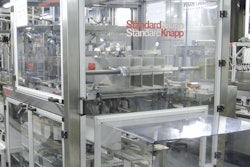The concern, of course, was that vital safety data would be compromised by other traffic on the network and in the controller. Today, however, advances in control and networking technology, along with the development of high integrity safety communication protocols like openSAFETY, permit systems to handle safety and machine control data with no loss of integrity.
Some in the packaging industry remain skeptical of this new approach. Plus, change costs money, so the obvious question is: Why change? This is a question that the proponents of integrated, or networked, safety love to address.
Tony Rigoni, a safety expert with Beckhoff Automation (www.beckhoff.com), notes: “Currently most users have two duplicate networks, one for controls and one for safety. By implementing two networks you must deal with twice as many controllers, wiring and software platforms.”
The cost savings are obvious. Add to that the savings in programming and commissioning time and cost, and the dollars can really begin to mount up.




























